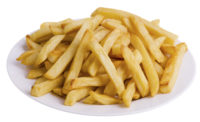There’s no getting around it. Nearly everyone has to cross a bridge to reach the ConAgra Foods Lamb Weston technical center in Richland, Wash. That’s because the Columbia River twists and turns through this section of southeast Washington and links the sister cities of Richland, Kennewick and Pasco.
Chris Rhynalds learned as much last summer when he moved to the area. Formerly a director of research, quality and innovation (RQI) with ConAgra Foods in Omaha, Neb., last April Rhynalds was named as Lamb Weston’s vice president of research and development.
Now Rhynalds is building bridges himself - including one that connects Lamb Weston’s proud past to its future; and another that connects its R&D program to other resources within ConAgra’s $11.6 billion universe.
“Lamb Weston’s strength has always been to drive new business through innovation and meeting customer needs,” says Rhynalds. “It meant working directly with foodservice and national account partners and learning about their needs, as well as introducing what we believed were innovative potato product formats and cuts.
“Now we’re charged with developing new products that are not out there, ones no one else is making. We’re also pushing into other new product platforms. We have a tremendous ownership position in foodservice potatoes and we’re looking at how we can establish a similar standing, for example, in appetizers.”
He continues, “We have R&D expertise within ConAgra and during the last couple of years [ConAgra Chief Executive] Gary Rodkin and Al Bolles (executive vice president of RQI) have worked to ensure that we take advantage of those skills. It means that we work smarter, not harder. Today, we have a much more integrated bridge between R&D departments here and in Omaha.”
Rhynalds says his team not only draws upon its own culinary expertise, but also that of foodservice chefs in Omaha. Likewise, Lamb Weston now works closer with sister businesses - bringing together product developers, chefs and sales representatives - on “coordinated, holistic” product solutions.
One example from last year: a pre-assembled skillet mix for a quick-service restaurant chain’s breakfast burritos. The pre-portioned mix includes Lamb Weston potatoes and vegetables from Gilroy Foods & Flavors.
Lamb Weston also is investing in more original consumer research.
Notes Rhynalds, “We’re taking advantage of our ability to gain consumer insights and our corporate resources in sensory testing and consumer testing. We’re also conducting consumer and customer/operator focus groups to validate that we’re doing the right things.
“Later, we can provide a grid of information to our customers and say, ‘Here’s our product design idea. Here’s what we learned from consumers and from that, here are our suggestions.’ Ultimately, we can more quickly arrive at the best end-solution for our customer.”
Sensory insights also help channel Lamb Weston’s research in key areas.
“One important trend involves bold flavors and not the same boring products,” says Rhynalds. “We’ve had some very successful introductions with products such as Stuffed Spudz, which are stuffed mini hash browns with flavorful combinations of cheeses, diced potatoes, chopped vegetables and seasonings; and World Rings (onion rings), which get around the standard boring batters to deliver bold flavor - even after frying - and give restaurant operators something truly new to feature.”
Not surprisingly, healthier foods represent another key area of development. For the record, ConAgra Foods Lamb Weston already offers My Fries, a complete line of coated french fried potato products with zero grams trans fat and 25 percent less fat than conventional offerings. Last year also brought Sweet Things, a line of sweet potato french fries and dices, and mashed- all with zero grams of trans fat and the added nutritional benefits that sweet potatoes provide.
Rhynalds notes that the February 2008 purchase of Watts Brothers - a diverse business with farming and frozen vegetable processing assets - has expanded his team’s outlook.
“The organic market is growing with customers - both here and overseas - demanding certified premium organic potatoes and vegetables. That acquisition adds organic growing capabilities and our technology groups will be looking at that.
“We also realize that people want to eat more vegetables and ‘eat their colors,’” he says. “We’re looking at how we can add value to commodity vegetables in different snack products to make it ultra convenient. That way, a consumer won’t have to work as hard to eat a balanced diet.”
Close-Up: Chris Rhynalds
Title: Vice President, Research & Development since April 2008
Previous title: Director-Research, Quality & Innovation, ConAgra Consumer Frozen Meals
Years with ConAgra: 18
Background: Graduated University of Nebraska (Lincoln) in 1985 with a bachelor’s degree in Agriculture and in 1988 with a master’s degree in Meat Science. Began working in 1988 as a food scientist for Harker’s Inc., a subsidiary of Holly Farms Corp. Joined ConAgra Foods in 1991.
What’s on his mind: “Regulatory issues and food safety. There are so many challenges in the regulatory arena in particular. These involve cases you see popping up in Europe, China and California with substances such as melamine or acrylamide. We’ve just hired a full-time director of regulatory affairs to directly support this [compliance] work for us.
“We need to know that our food supply is secure from end to end. It’s all about knowing as much as we can - the conditions when an ingredient is grown to when we deliver to a customer. We want to have full supply chain knowledge and confidence.”
He gets around: Since joining Lamb Weston, Rhynalds says he has met individually with every scientist and researcher at Lamb Weston’s Technical Center in Richland. To better understand the business’ capabilities, he also already has toured 15 of Lamb Weston’s plants worldwide.
Related Articles
Events
View AllSubmit An Event-
September 30, 2012 Leveraging Supply Chain Management for Enterprise Development
×
Get our new eMagazine delivered to your inbox every month.
Stay in the know on the latest food and beverage manufacturing markets.
SUBSCRIBE TODAYCopyright ©2024. All Rights Reserved BNP Media.
Design, CMS, Hosting & Web Development :: ePublishing
